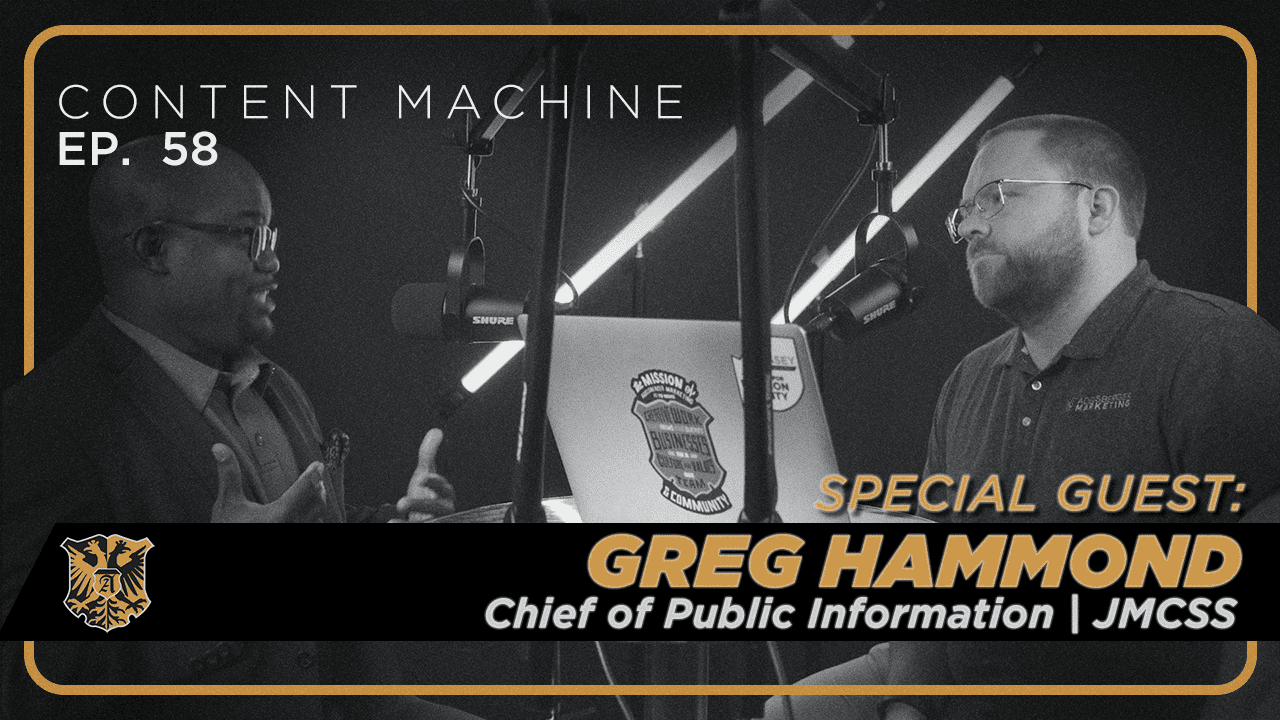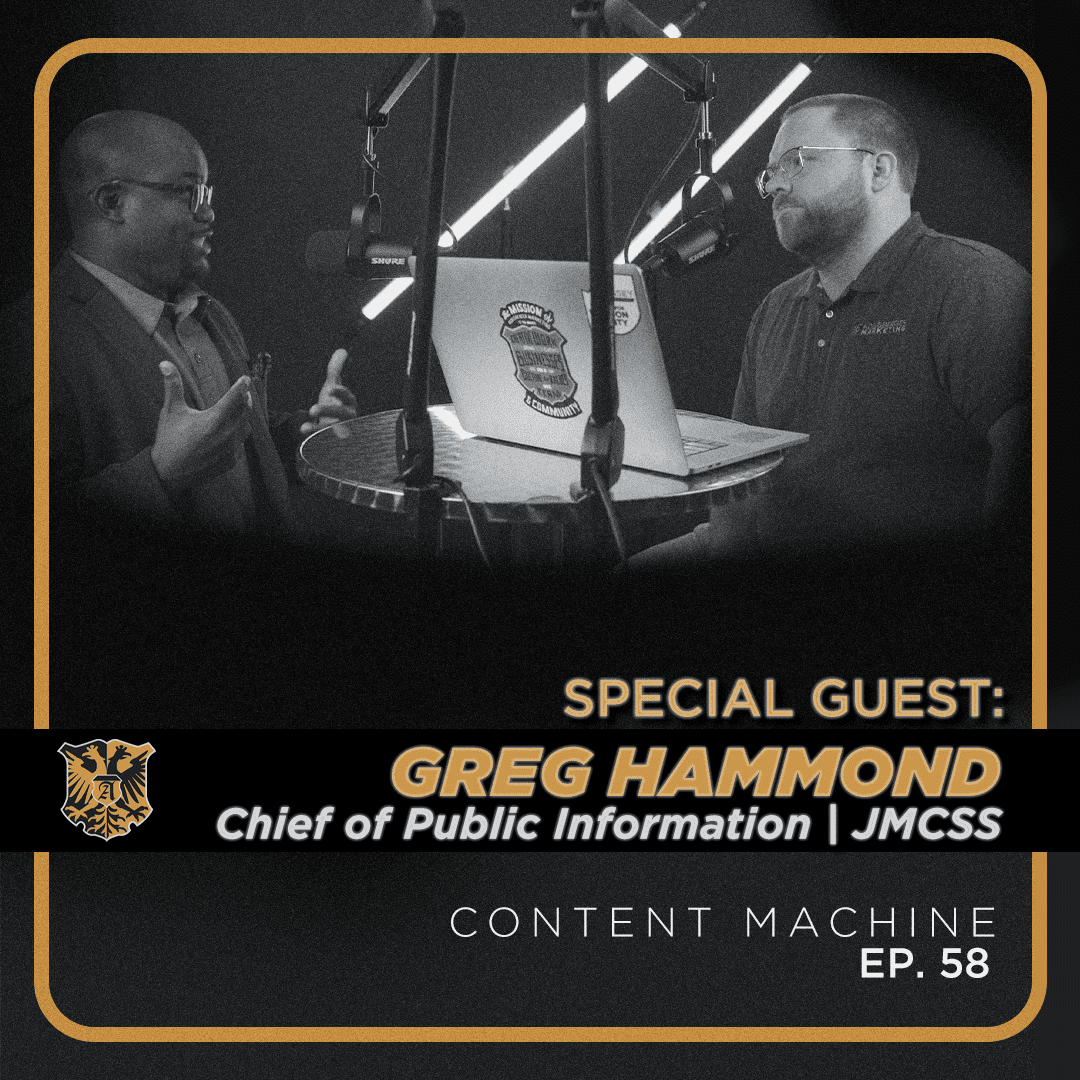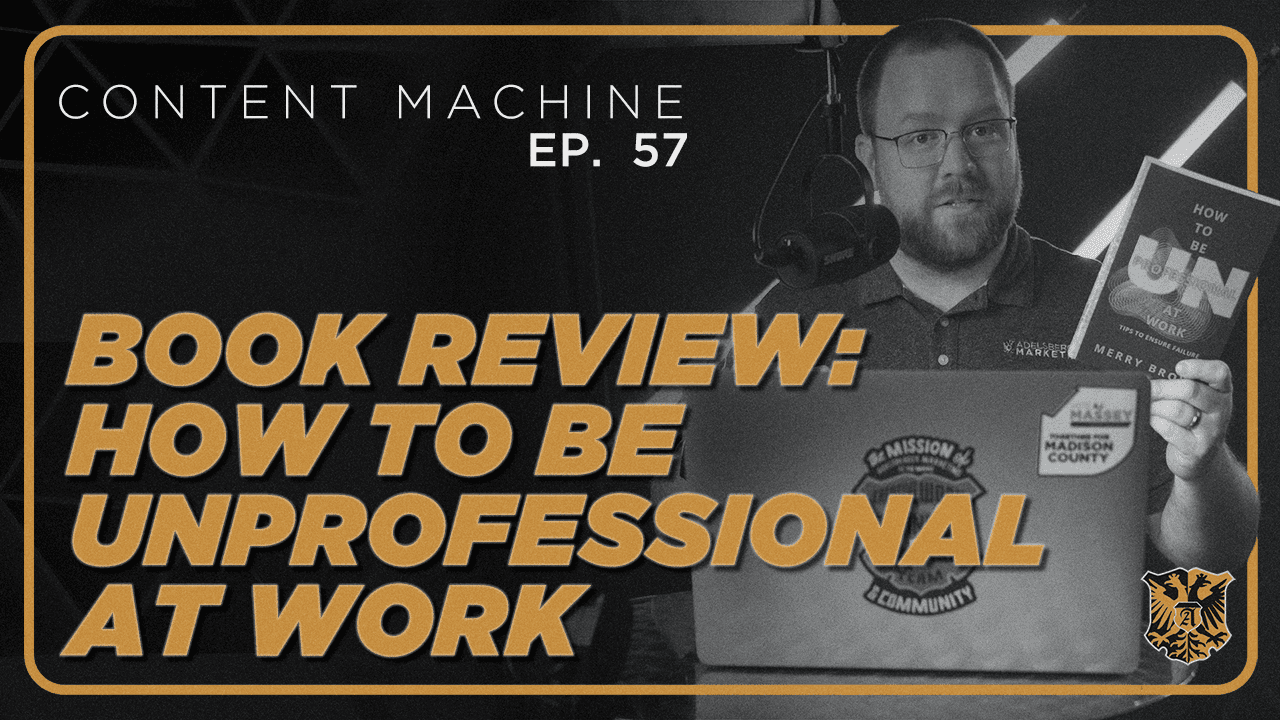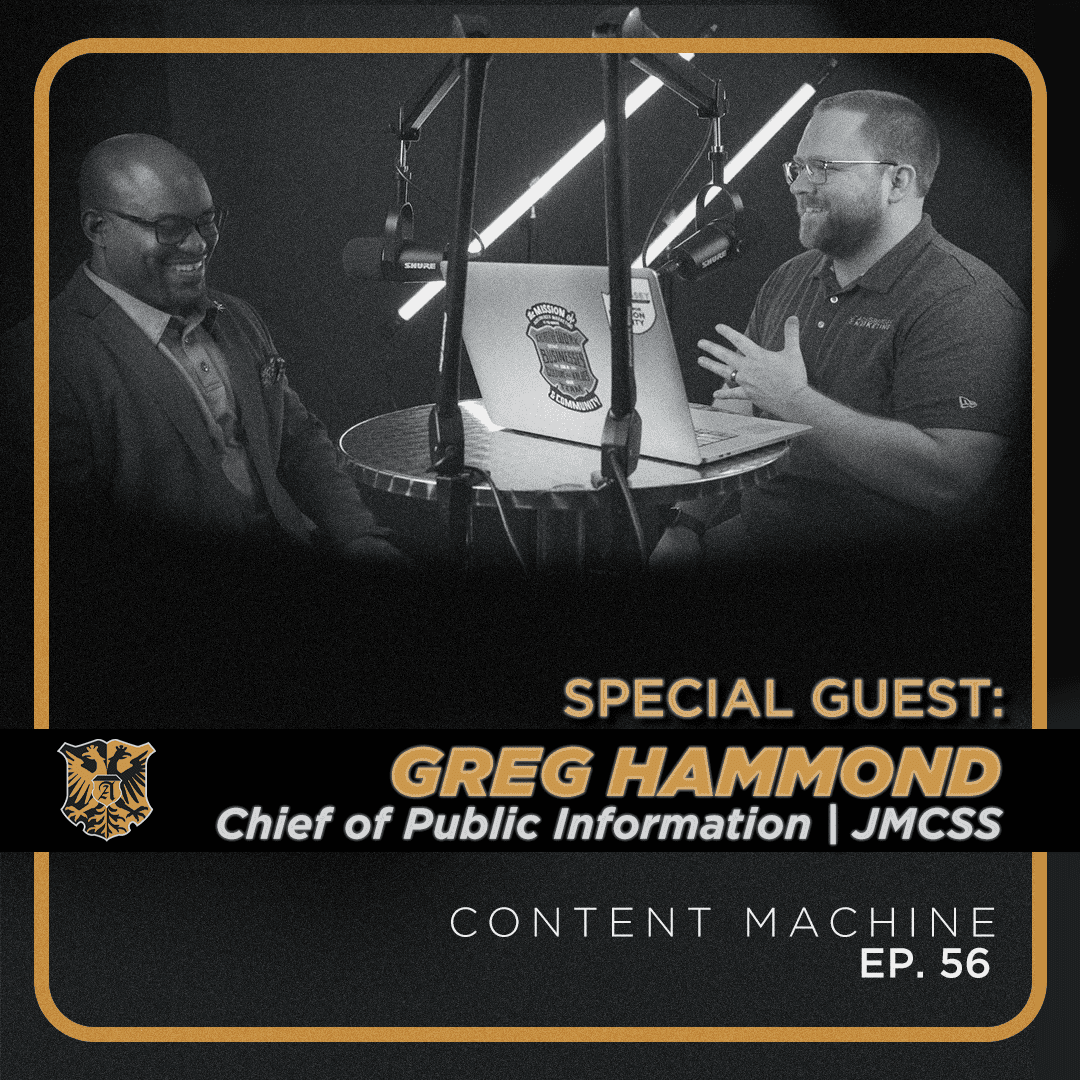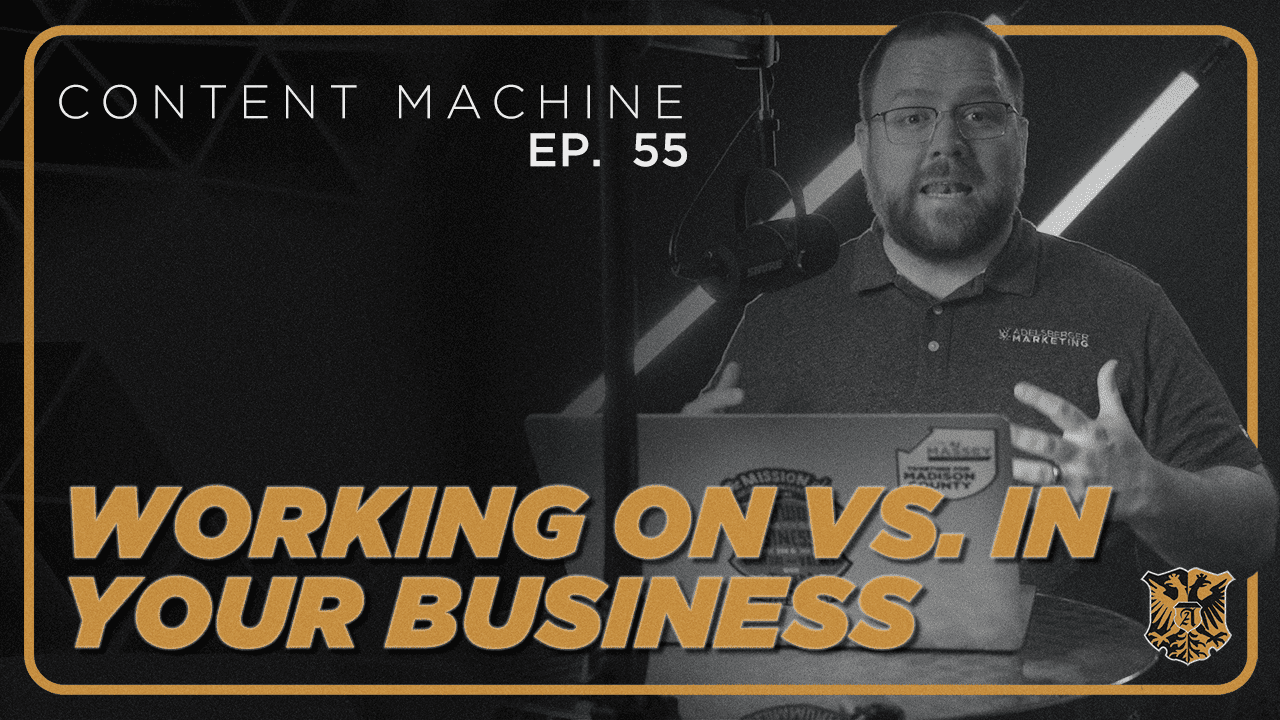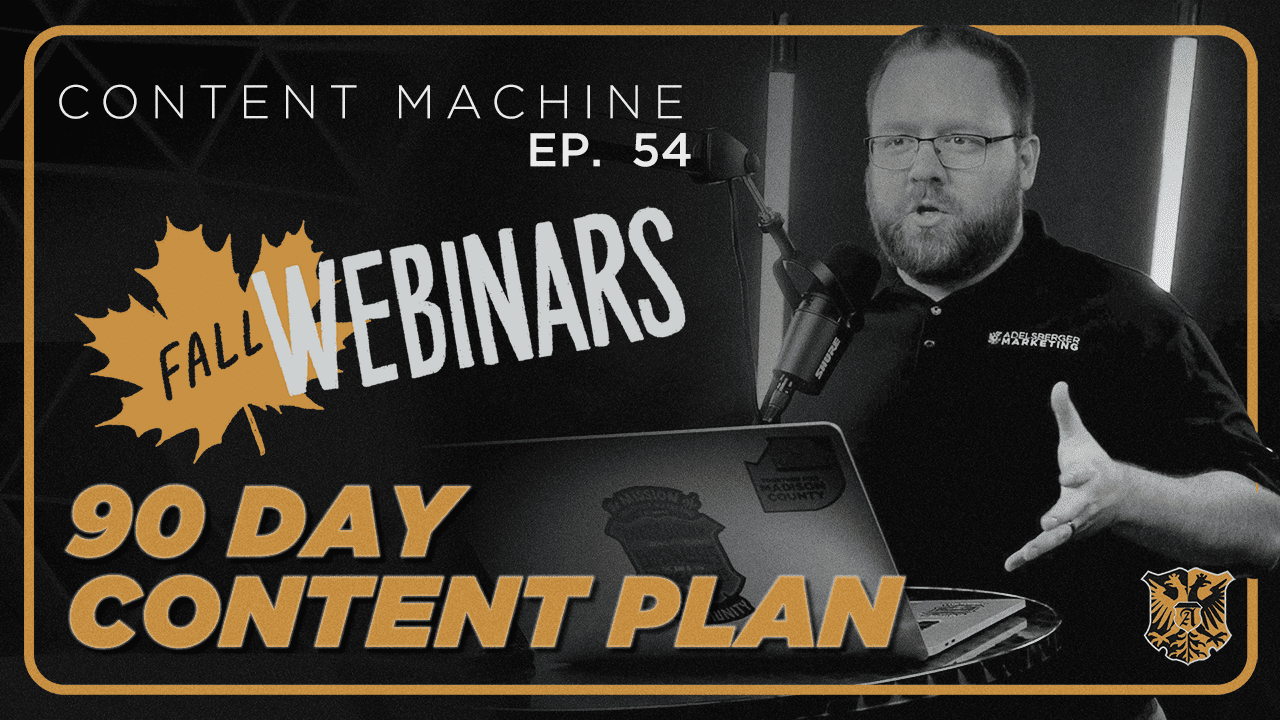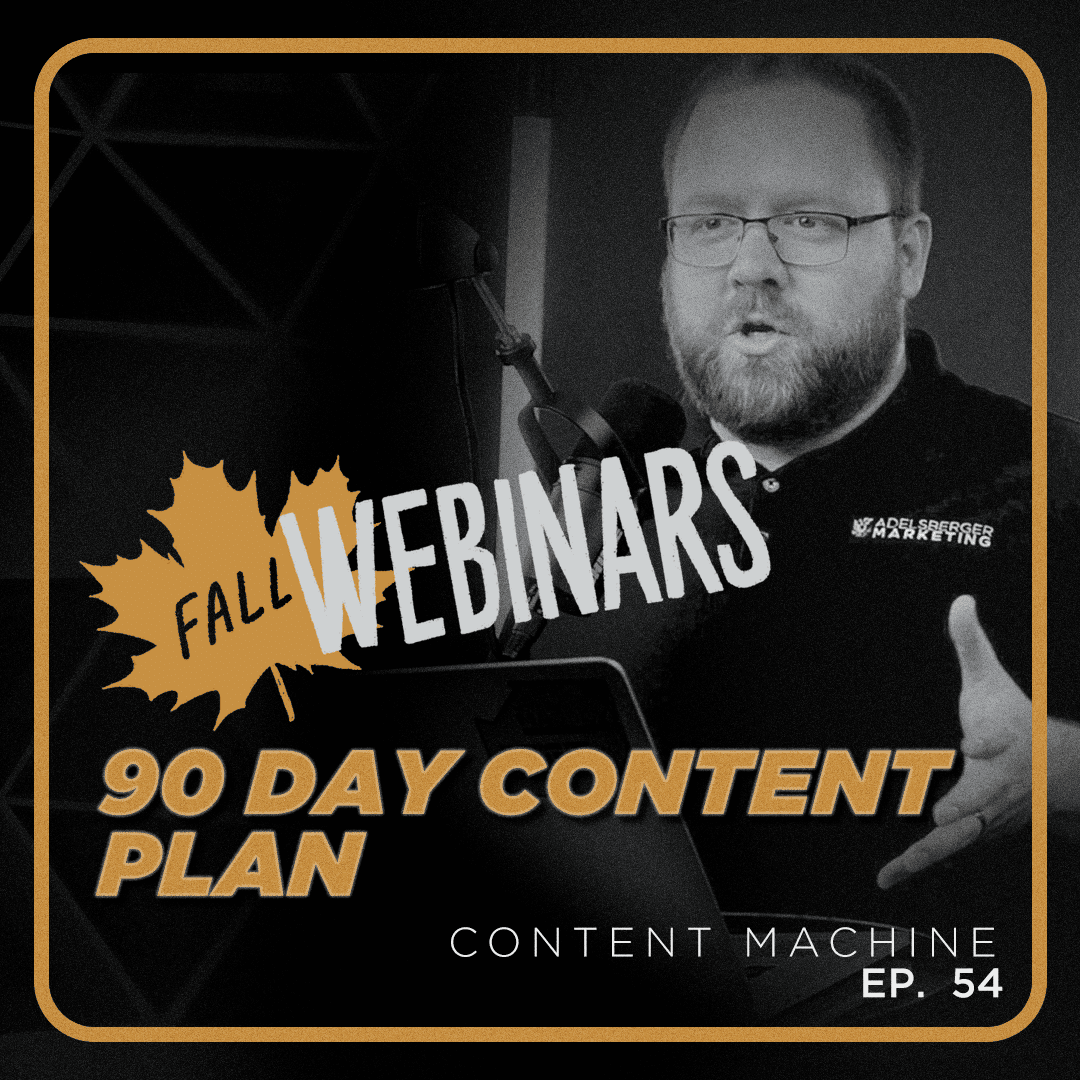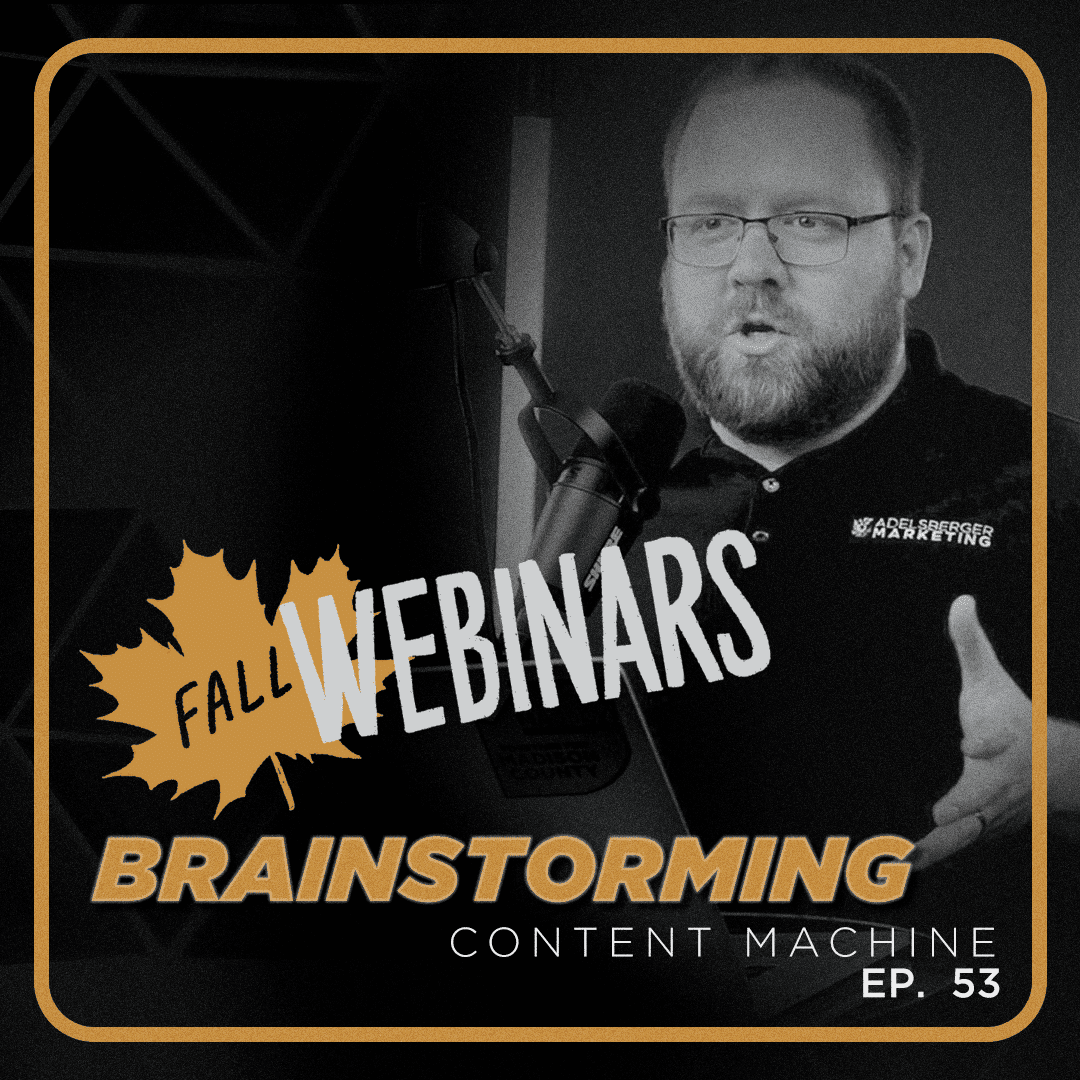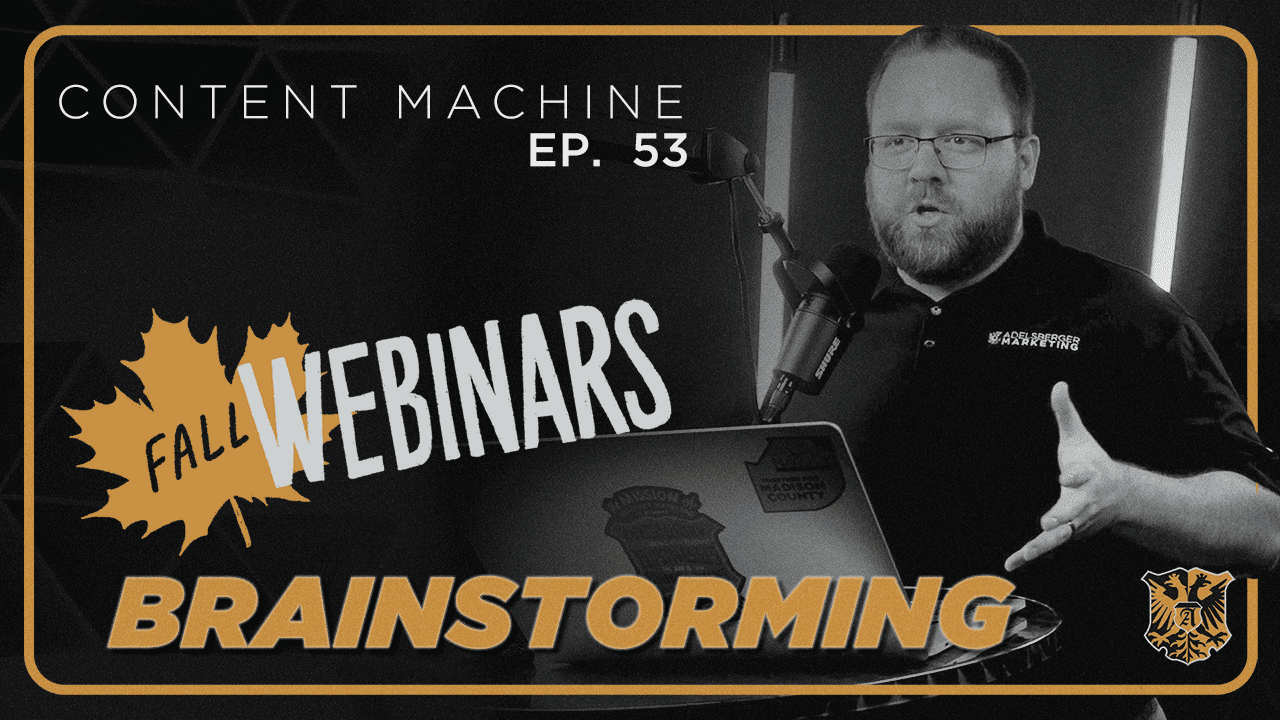Thank you all for coming to the last webinar in our fall webinar series on the 90-day content plan. Just an overview of what we’re going to go through here is we’re going to go through a little bit of a content strategy, content thought process on how to develop some different types of content. We generate a lot of content at Adelsberger Marketing, and we know it can be a challenge to keep the ideas flowing sometimes. We’re going to walk through some ways, some formats, and then there’ll be a nice PDF that you can download at the end that will have a lot of this information on it. Then at some point, I may even ask if someone wants to come and share an idea that they generate throughout the process. We’ll keep that in mind. If you have a question as we go, I believe the chat is set up properly this time for chats to come through to everybody. There’s also that question and answer tab I have in here. So whichever tool that you want to use to ask a question along the way, feel free to do that. So let’s dive in. So when we think about content, we need to think about what can we talk about?
So that’s the first thing that we want to start with. So what can we talk about? What are things we could talk about? And this is just going to go through a long list of things that will hopefully give you a place to jump off of when you are starting to build your content plan. We’ll start with who we are. As a company or as an organization or as an individual, who are you as a company? Is it the people? Is it what you care about as a company? It could be featuring staff. Is there a way that we can feature staff? One thing that we do here is every staff member’s birthday, we do a highlight about them on social media. Some people do that with anniversaries. There’s different things you can do. Mission and vision as a company is a valuable thing. What do we care about beyond work? I think this is a really good one to shape some content around. If you are a company or an individual that is really invested in a cause, being able to align yourself with that cause through content is a really powerful tool. Things that are core to our mission.
If your mission is to do something outside of the company, or if it’s part of our mission is to grow our clients’ businesses or to give our team members a great quality of life. If we can find ways to feature those in content, that’s a great concept to work with. The second thing is, what do we want to promote? The first thing is talking about things about our company and about the people involved. The next part is, what do we want to promote? We might be wanting to promote our products. You might have different things, different product lines that you want to promote, different services that you might want to promote. But really here is like specialties. Is there something that you do in your marketplace that only you do in your marketplace or that you’re better at than everybody else in your marketplace? Are there specialties that we can promote? Now, on top of that, and more important is, what does our audience care about? As a company, you’re going to do some of those things that are promotionally, whether people want to hear it or not. But you need to be thinking about what does your audience care about?
There’s a book by Gary Vandertruck that’s a really classic work in content marketing at this point called It’s called jab, jab, jab, right hook. The jabs in boxing are you wear down your opponent and you get them not paying attention to the big right hook that’s coming, which is the big haymaker, the finishing shot. So jab, jab, jab is like, what are things that we can share that they’re really interested in so that they’re paying attention when we drop the right hook of the call to action we need them to take? For us, it’s like, Well, what can we get them to pay attention to so that when I do a webinar, for example, the webinar is the right hook. The jab, jab, jab is our team sharing what we’re working on or featuring work that we’ve done with our clients or things of that nature. Another thing that we think about is, do we want to document what was going on? Do we want to create create some specific content? Document, are we showing the things that we are doing as a company? Are we taking pictures of meetings that we’re having or that we’ve got a new shipment in that was really exciting or some behind-the-scenes opportunities?
Or are we creating things like writing a webinar or writing a book? Those are two different thought processes, and the document is really easy to accomplish, but the trick is you have to remember to do it. The create is a lot more work, but usually they have a longer life cycle. For example, and we’ll talk about reutilizing content across platforms here in a few minutes, but this webinar will live on in different ways. It’ll be in our podcast in January. The document that we created to download for people to guide people through this process is going to become the new lead generator on our website. We’re getting as much out of this process as we can as a company. When you create content, there’s more of an opportunity to reuse that in multiple places. Builders and drivers is a similar thing, but really going back to, are there competitive advantages that we can take and showcase in our content that only we can do or we do better than anybody else, or we’re the only game in town for this thing? Most of you have something like that. You just may not be able to communicate it very well.
Spending time to refine that and to communicate that is a critical piece to making good content. Then I would also say cool or exclusive access things. So behind the scenes content. I’ve done a lot of work with factories throughout different components of my career, and being able to see what happens behind the scenes at a factory is really interesting to me. Not to everybody, obviously, but to me, it’s very interesting. But you don’t just You can’t just Google what’s happening at [insert factory name here] down the road. Or I have an advantage that we do a lot of video production show, showing behind the scenes on the set of what we’re working on is cool and exclusive access. You don’t get to see that unless you’re there. There’s probably opportunities for you to find things that are only you get to see that aren’t sensitive enough that you can’t share it, but people aren’t going to get there to be able to see it in real life. Then things like time-sensitive things. I remember a couple of, maybe two years ago, Fleetfeet in Jackson or Performance Running. I don’t remember which one it was at the time.
I think it was Fleetfeet at the time. They put up on Facebook, they’re like, Hey, we have a limited number of shoes. They’re on super sale. They’re out front. Well, people descend it upon Fleetfeet because of the cheap running shoes. Let’s go check it out. And so time-sensitive things are another thing to look at. What I want you to do is this list of things is something that you can go back to and back to over time to say, Okay, maybe we just work our way down this list as we go through things. We’re going to talk a little bit more about how to use that as we go forward here. We like to brainstorm at our company. The last webinar that we did was all about brainstorming. There’ll be a link to watch that here in a minute that you can scan a QR code for. We like to use Post-it notes when we do that. When you write Post-it notes, you don’t put all the ideas or phrases on one Post-it note. You put one idea phrase per Post-it note. So your Post-it notes look like these. Then you can go through maybe with your team or with yourself or with some friends that are helping you think through how to do this for your team, for your business, for your organization.
Just start, go back to this list, what we can talk about, and take 60 seconds each one of these, and as a post-it note, generate as staff. Okay, should we talk about birthdays or anniversaries or career accomplishments or community involvement type of things? Spend some time and brainstorm through all those components, and then we did a webinar on brainstorming in this series, so feel free to scan that QR code. I’ll leave it up here for a second. That will help us. That will give some more framework around our brainstorming strategy. So check that out. But the next thing we need to think about is our customer awareness levels. Now, this next slide is a preview of all the content in this webinar, and it’s also in the downloadable PDF that we’re going to share here in a minute. We’re going to start with customer awareness levels. When we talk about what can we talk about, we’ve got that list of things that we think are these are things that we could share. We also need to think about how much the customer is aware of us. In a difficult situation, customers don’t know who you are, and they don’t know that they need your product.
We’re working with a new company right now who is going to have to educate the market on their new service. That is a very difficult and costly proposition, but it also gives you the opportunity to be the leader in the market. But most likely, you are going to be in the customers who are aware of your product and they have a need, or customers who don’t know your product exists but know that they have a need for your product. Going back to working with us, they might be aware that they have a need for marketing, and they might have heard of us, but they’re not ready to sign up yet. Or it could be customers who might not know that websites exist, but they know that they have a need to market their business. When you think about that content, you take that list of things that we could talk about, we got to map it occasionally against this awareness levels because you’re going to approach that content in very different ways. If you’re talking to people who are ready to sign up, but they have not bought your product yet. For example, I’m not going to do a mailer that has “Purchase this video service for 25% off today.”
That’s not the type of customers we work with, for one. But with fast food and things of that nature, customers who are ready to sign it but haven’t bought from you yet, that top corner, that’s where a lot of people are with things like fast food or fast casual dining. Coupons can help push you across that level. And your business will be different based on your situation. We’re more in that middle two levels that customers who are aware of your product and that they have a need, and customers who don’t know that your product… But they know they have a need for your product. We’re somewhere in those two realms. But that is going to shape the way your content is communicated, because if you’re talking to people who already know who you are and things like that. You can leave a lot of details out. But occasionally, you need to have some introductory content or frame things in a way that people don’t know who you are to help communicate that a little better. The next component is content structures. What are ways that we can take that? What do we want to talk about when we shape it through how much people know about us?
What are some formats that we can stick that into? This is a list that we work with internally when we’re brainstorming content. Is it an announcement? That’s pretty plain and not clear. People know what an announcement is. Is there some community aspect that we can use? Maybe that’s helping people generate content for us or crowdsourcing information. Is there an expert opinion component to it where because we know what we’re talking about, we can give an insight on something that maybe others do not have, get to know you It’s like, here, introduce you to this person and what their skillset is or maybe their background or where they’re from or what they care about. Printing a guide or having a guide that can be downloaded, much like this webinar guide that you’re going to be shared I’ll talk to you here in a few minutes. Then with our holidays. There’s so many holidays that you could talk about, and we’ll talk a little bit more about that in a minute, but there’s different things there. How to, so step by step on What do you need to do to be successful with X thing that we know about?
Listical. List plus article. Listical. These were made famous by buzz feed back in the day. Can you create a list of things that are relevant to your customers based on that what can we talk about feature and then create a article that’s a list, a list article out of that? Can you use a meme to communicate these things or to make a customer laugh or to engage someone? Sometimes there’s a poll like, what color do we want to bring in this season type of thing. There’s an opportunity there. Asking a question of the community, get them to submit questions is a great way for engagement. Maybe a quiz that’s like, Hey, do you need cybersecurity support. That could be a quiz option. A special is like, we have something on sale today, and testimonial is like hearing from a community member or a customer that talks about how good you are doing. What we’re going to do as we work through here, eventually we’re going to map all these things together and be able to generate some frameworks for generating content. Once we’ve got the content structure, we have an opportunity to pick some mediums to accomplish these things.
This is another thing that we use internally when we’re thinking about how we build a piece of content. You can start with animation. We’ve got a great animator on our team, Ricky Santos. Or maybe it’s an audio file, so maybe you should start a podcast or it could be an episode for your podcast. Maybe it’s a PDF document, a short form, like here’s a guide, like this is going to turn into. Maybe it’s an e-book or a print book that you could have as a giveaway to people. Graphic, is it something that could be communicated quickly in a graphic, maybe an infographic, or maybe just like icons or shapes or like an illustrated type thing? Interactive, like that poll or quiz could be or a web page experience is a way to share something. Live video, so is this something that we could go live about? This is really great for things like the documentation of things? Is it something that could be communicated in a photo? Stories is a combination of several of these, but it’s really a content-specific placement. But it’s something that you should be thinking about on how to create content that’s shaped to stories and being active on those on a regular basis.
Is it something that we need to write? Is it a blog? Is it an article that we submit somewhere? There’s a text there. And Lorem Ipsum, for those of you who don’t know, is like, if you’re building a website or building a print document and you don’t have the actual text in there, there’s something called Lorem Ipsum. It’s filler text. So that’s why that’s used there. And then lastly, it’s like video. Is it something that we should make a video about to help explain it? And maybe that’s filmed with your phone, or maybe you go to a studio and record a really professional version of that. Related to that is thinking about what platforms is that content going to show up on? Facebook, Instagram, LinkedIn, TikTok, Twitter, or X. Is it going to be email marketing? Is it a podcast? Is it a YouTube video? Thinking through where that’s going to go or all the places that it’s going to go is going to affect the way you create the content. Keeping that in mind as you plan the content out is really important. We also like to think about what emotions do we want to elicit in the content?
Let me walk through these real quick. Obviously, happy. Do we want to make someone happy with the content we’re reading or creating? Do we want to make them sad? There could be good reasons to make someone sad about content. Do we make them angry about content? We need to be really careful about doing this. There are some things like politics that abuse this. Do we want to make someone feel cool? Like they know about something that nobody else knows about or they are excited about that for us. This is embarrassing. Did I write this down? I can’t remember what that face is. Curious or a shock. I’m sorry, it’s shocked. Do we want them to be shocked about the content? Sometimes, yeah, there could be a reason that an expert opinion could be shocking to someone. Do we want to funnel it that way? Because thinking about that emotion is going to help how you shape all the other parts of the content. Question, do we want them to make them curious about what’s happening? There’s a way that a video can make someone curious about the content that you’ve generated. Then the The last one is an internal joke here at Adelsberger Marketing.
It’s called pirate. The pirate emotion is honestly, when we made this list the first time, we needed one to round it out for the space that was in, and I just wrote pirate. It’s been a running joke in our company ever since. If you can make someone feel like a pirate, it’s never a bad idea. Then we want to think about holiday cultural events. We keep a running list for our brainstorming sessions for our content generation that we look at national holidays that are coming up in that quarter. Are there theme days like National Barbecue Day that we can utilize or manipulate, honestly? Then are there local holidays in our area, in my area in Jackson, Tennessee, which most of you are in, we have 731 day, Memphis has 901 day. Are there local holidays that we want to make sure that we capitalize on? I’ve talked really quickly through those. We’re going to walk through them a little bit slower here. We want to put it together in a Mad Lib type format. We’re going to take one category from each thing and then build a cohesive piece of content. Let’s walk through that again.
What can we talk about? We’ve made a list. We’re going to pick one out of there. Customer awareness level, which one of those four are we talking to? The content structure, what is the form of the content? The medium for the content, how are we producing that content? The platforms that it’s going to go on, and then what is the emotion that we want to trigger when we’re watching that? For example, a couple of years ago, we got a new camera. I really wanted to share about the new camera because it was super cool. It’s still super cool. But most people don’t care. But people that know us, people that are aware of us and are close to us, their customer level four, they’d be interested to know that we’ve got a camera that’s going to make our lives better and make the product that we make for them better. Content structure, it was an announcement that we had this new camera, and it was a video. We recorded a video that was funny, but ultimately, it wanted to be people to feel cool We used our smoke machines and our cool lights and made it interesting.
Then we were going to use it on Facebook, Instagram, LinkedIn, X, and YouTube. We used it in a lot of different places. This is another way to think about it. If that’s not driving with your brain, it’s like, We’ve been needing to reach our customers who care about X, so it’s time for some content about X, and we’ll share it. We’ll share a blank, which is your medium on blank, which is your platform, to bring customers a sense of the emotion there. What I’d like to do now is I’m going to go back to that opening slide that has all that information on it. What I’d love for you to do is to take a minute and generate two or three ideas. Then when someone’s got one that they’re willing to share, I’d like you to raise your hand in the participants panel, and I’ll bring you up, and we’ll talk through it, and we’ll see if I have any feedback, or if you just do a great job, then you get to flex on everybody else in the audience. Take a moment and think about that, and then if someone raise their hand when they’ve got one following this methodology here.
Oh, I knew it would be. All right, Ginger Williams is allowed to talk. Ginger. I don’t know if I did this right, so I was scared. Can you hear me? I can hear you. Yeah. Okay. I don’t know if I did this right. I put down, We need to reach people who want to list their house for sale. I’m a realtor, and they don’t know who I am. So we need to do a get to know video so they feel like they know an expert they can trust. Is that what you were looking for? Yeah. I think that’s a really good… Because a lot of times you may assume that everybody knows you already. That’s right. I think that’s how I usually make my content. Just thinking about those four categories, I was like, I don’t know if I ever make content for people who don’t know me. Yeah, I do the same thing. It’s really easy to avoid that. That’s something I need to work on, too. Ginger, thank you so much for sharing. I’m going to disable talking, I guess. Anybody else want to share since Ginger was brave and broke the ice for everybody else?
All right. While you think about that, we’re going to make a really quick promotional stop since I’m doing this for free. Adelsberger Marketing, just three things I want you to know. One is we’ve got a podcast that we do every week, and you can get that for free on any of your podcast platforms or watch it on YouTube. We do our best to make really interesting content that is helpful for people who are in leadership or marketing or interested in company culture. The second thing is office hours at the Co. If you are intrigued by anything I have to say, I do a free office hours visit with the Co every second Tuesday. You can sign up for a 30-minute virtual meeting with ask me whatever you want about marketing. Let’s clarify that. Anything you want about marketing. I will do my best to answer that. Then the third thing is my team is available for brainstorming sessions for content. Those are $3,000 and they last about half a day. If you are in a place where you’re like, I need someone to help me generate lots of content ideas and work on an implementation plan, we’re the people to contact.
We would love to work with you on that. How do we ensure success? Let’s take this. Let’s say Ginger has come up with that idea like she did, or I’d come up with the video idea for us. How do we make sure that this happens? Well, the first thing is you can download this planner that I would recommend. You can scan that QR code. I’m also going to put it in the chat here, a link to download that 90 day resources. In that Google Drive folder, you’ll see two things. You’ll see the big PDF that has all the things that I just talked about and the Madlib set up, and then one that’s just the Madlib set up. If printing it out and filling it out is helpful to you, you can use that. First, you need to think about what’s a reasonable goal for content generation. Are you going to go crazy and do 10 pieces of content a week when you first start? Likely not. You’re setting yourself up for failure if that’s your goal. So what can we do to ensure success? We want to make sure we start by calendaring it out.
Let’s try for 2-3 pieces a week. Let’s get in the habit of doing it. Let’s make baby steps towards success. Let’s generate two pieces per week using this formula to try to get us there. Then we need to think about who’s responsible for making that happen. I know some of the people on this channel that I’m seeing are independent people and they work by themselves. Some of you are in large organizations. It might just be you that’s responsible. But if it’s not, who else needs to be involved? If you want to post it at a certain date and time, which I would recommend to do that, plan that ahead of time. When does it need to be ready to be approved or reviewed by whoever needs to approve or review it? What’s the timeline to create it? We’re working backwards from if we want to post something at 6:00 PM on Thursday, December seventh, how far in advance do we need to be working on that to get that done? A failure to plan is a plan to fail. Can we work on a timeline? I know this all of a sudden sounds like a lot more work than it does, but if anybody here is in the business of producing content on a regular basis, it is a lot of work.
How can we make sure that we’re breaking this down in a way that will help us be successful? Think about the timeline to create it and plan out the steps to do it. If that is every Monday, I’m taking an hour and I’m generating ideas using a framework to help me create a list of things, that’s one of the steps to be successful. Plan out all those steps to building that calendar out. I would recommend doing that calendar 2-3-4 weeks out at least so that you are, for me anyway, the mental load between starting an idea from scratch and then having to execute that idea are two very different loads on my brain. I like to separate those two activities as much as I can. For example, with our podcast, I generate ideas on that on a quarterly basis. Sometimes the team is involved, and I will write out a couple episodes ahead of time, and then I record them at a different time because the workload is different, and I need to separate those two things for me to be successful. Then is there accountability involved? Is there someone in your organization or is there someone that you can partner with to make sure that you’re doing the things that you say you’re going to do.
Accountability changes a lot of things. If you have to respond to someone who said, Hey, did you do that thing that you said you were going to do? And you have to say no, that is a motivating factor for a lot of people. And so can we motivate ourselves with accountability? And then this is a big one. I try to offload as many things from my physical brain as possible onto a digital brain. And so there was a time when I was producing a little video about my day every single day, and you’d think I’d remember to do that because I was doing it every day for almost a year. No, it didn’t help me remember it. I would forget it. And so I literally set reminders on my phone throughout the day and said, Hey, do you need to record anything? Have you recorded anything? In this instance, set reminders in your phone. If you’re going to try to do documentary content from behind-the-scene stuff, set reminders to remind you. It’s like, Have you posted anything behind-the-scenes today? Or set calendar events to say, Hey, this is what I’m working on content, or this content is due here.
Treat it like a work assignment and make a timeline to make it possible. I always am trying to figure out more ways to make my brain have to remember less things because that makes me successful. The second thing you want to think about is how do you maximize that content? If you are spending the time to generate content, how do we use it in as many places as possible to make us successful? So one, can you use it on multiple channels? Most of the time, the answer is yes. Now, you should think about, are there reasons for me to customize this by channel? Or can I remix this in several ways? So for example, with our podcast, I write the podcast, we record the podcast, then we turn it into a blog article, we turn it into a YouTube video, a audio podcast, and then we cut out clips of it that we put on social media. We put those in a lot of different places so that we feel like we’re maximizing the use of my time on content generation. Can you use it in multiple places? The next thing is tracking and analytics. Now, one thing I will caution you here is your initial analytics might not be encouraging.
That doesn’t mean that you should stop. It may mean that you need to rethink about what you’re doing. But my encouragement is to push through the first little bit, regardless of how the analytics show, so that you give yourself a chance to be successful over time. But what are ways that we can track that as well? Social media has built-in tracking tools, so you can see what’s happening. If you are working with something that ultimately people need to go to a website to learn more about, there is Google Analytics can track traffic coming from your social media channels. I know a lot of people don’t look at their Google Analytics on a regular basis, and you should. Then finally, you can use things like bitly links, which is bitly. The 90-day resource link that I dropped in the chat a minute ago is a bitly link. Essentially, what that is, it takes a longer link and shortens it with a title, and then allows you to see how many people clicked on that. Our church is currently hiring a new staff member. When I had the church administrator send out a Facebook social media post about it.
I made sure I got a bitly link so that I could just see quickly without having to go to Google Analytics or anything, how many people clicked on that. And so very quickly, I can look, just refresh a page every day and be like, Oh, yeah, 152 people or whatever we’ve clicked on this. Bitly links are great for quick tracking of things. And then, UTM parameters are something in Google that allows you to get a little bit more detailed on what that content came from or where that content was going. The other thing that you want to think about is sponsored posts. Do you have a budget that you can use? I mean, social media really requires some buy-in at this point of paid content. You shouldn’t necessarily boost everything that you do, but you should look for home runs to spend things on. If you have a piece of content that’s doing really, really well, I would drop 50 or $100 on it to promote it to more people. Then sometimes you need to design content just to be promoted. Using Ginger as an example, because she spoke up a minute ago, when she creates that About Me video and wants to show it to people who don’t know who she is, spending a couple of hundred dollars on that over a couple of months to just be latently out there introducing her to people on sponsored content would be a strategy that I think would be probably worth pursuing.
Investing some on sponsored posts is a great way to maximize our value on the content that we’re generating. Once again, this is the bitly, this is the QR code to scan to download this guide. What do you do now? Generate ideas. Spend some time generating ideas using that methodology. Spend some time sorting through the best ones, plot them out on the graphic on the last page of this guide. There’s a calendar that you can write dates in and put pieces of content on them. Then go to that, be accountable, Who’s going to help you make it happen? And then go to work. Put the work into progress, start making some content, and track it and see if you’re successful or not over time. Right now, I can check this bitly link and see that nine link clicks or nine scans have happened. So that’s the great advantage of bitly links. Ginger asked a question in the chat. Would love to hear more about how to decide which post to spend money on. When do you decide money on that? Only after it does well. There’s two thought processes I would generally bring to the table with this.
One is if I’ve got a piece of content that I wasn’t necessarily planning on sponsoring but that it’s crushing it and it’s helpful to my business, there’s two things there, then I would consider spending money on it. You might have a post that crushes it that doesn’t help your business. Our April Fool’s video every year for our company, we love April Fool’s videos at Adelsberger Marketing, especially making fun of things that are going on the community. This year, we made fun of the Bicentennial, and I got 200-year coins made for Adelsberger Marketing. We did a video about that each year type of thing. I love that people see that and get excited about that. It’s really difficult to run ads on a video for one day, and so we don’t typically spend money on that, even though it usually does very well because people are engaging with it. But there could be a post like when we release our demo reel video for the year and we review the things that we’ve done in the past. If it does really well, we usually put some money on it to help promote it. The third category that I think about is, are there things that we are doing that we want people to see?
The webinar sign up was something that I was like, We’re going to spend money on this because if nobody shows up, this was a waste of time, and I’ve wasted my time and the time of my team to design the slides and the graphics that Katie was doing for the webinar download and things of that nature. That’s something I want to promote. I have a set budget that we will use for things that I know that we need to promote. We also promoted it organically and natively, and we found partners to promote it, too. The CO was always really nice to share our webinars that were coming up. But we did spend money on that so that we either think of organic content that’s going to help our business do well, that’s doing really well, or things that we know we want to promote and make people see. The stuff that we know What we want to promote that we’re going to make people see is really more of that right hook stuff, generally. It’s the things that are going to make a really difference in the set up for the business. I hope that answers that question.
If there’s any other questions, now it’s a great time to ask it, or I’m going to shut it down in just a minute. Chris Anne asked about the link. I put another one in the chat, but I will also email you one after this call to get a link for the PDF if you don’t have it now. All right. Well, thank you all so much for your time in coming to the webinar, and I hope you’ll have a wonderful day. If we can ever be of help, check out that 90 day. I’m sorry. Check out that Office Hours with the Co. We’ll be taking questions from people in about a week. Hope you have a great day. Thank you so much.

